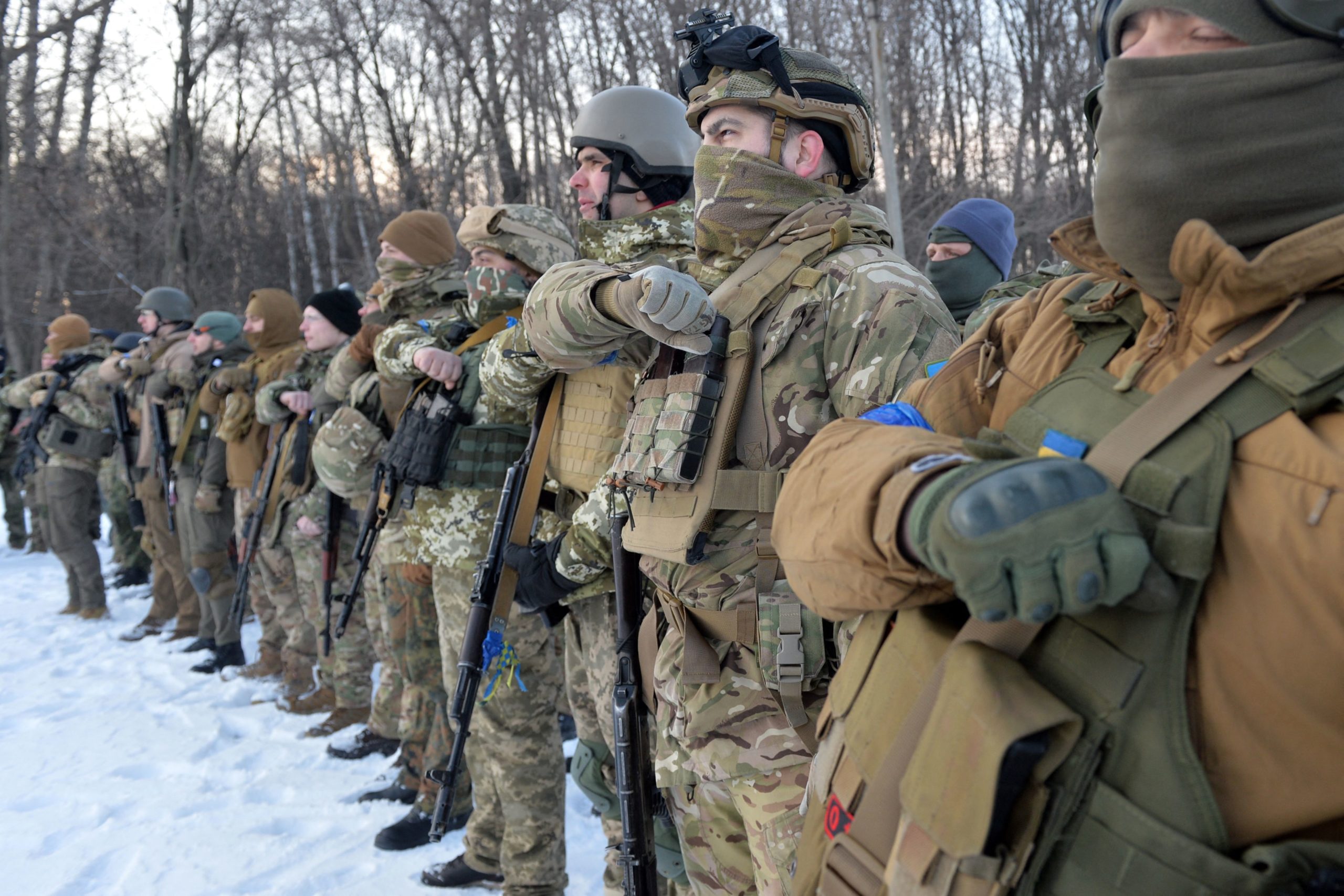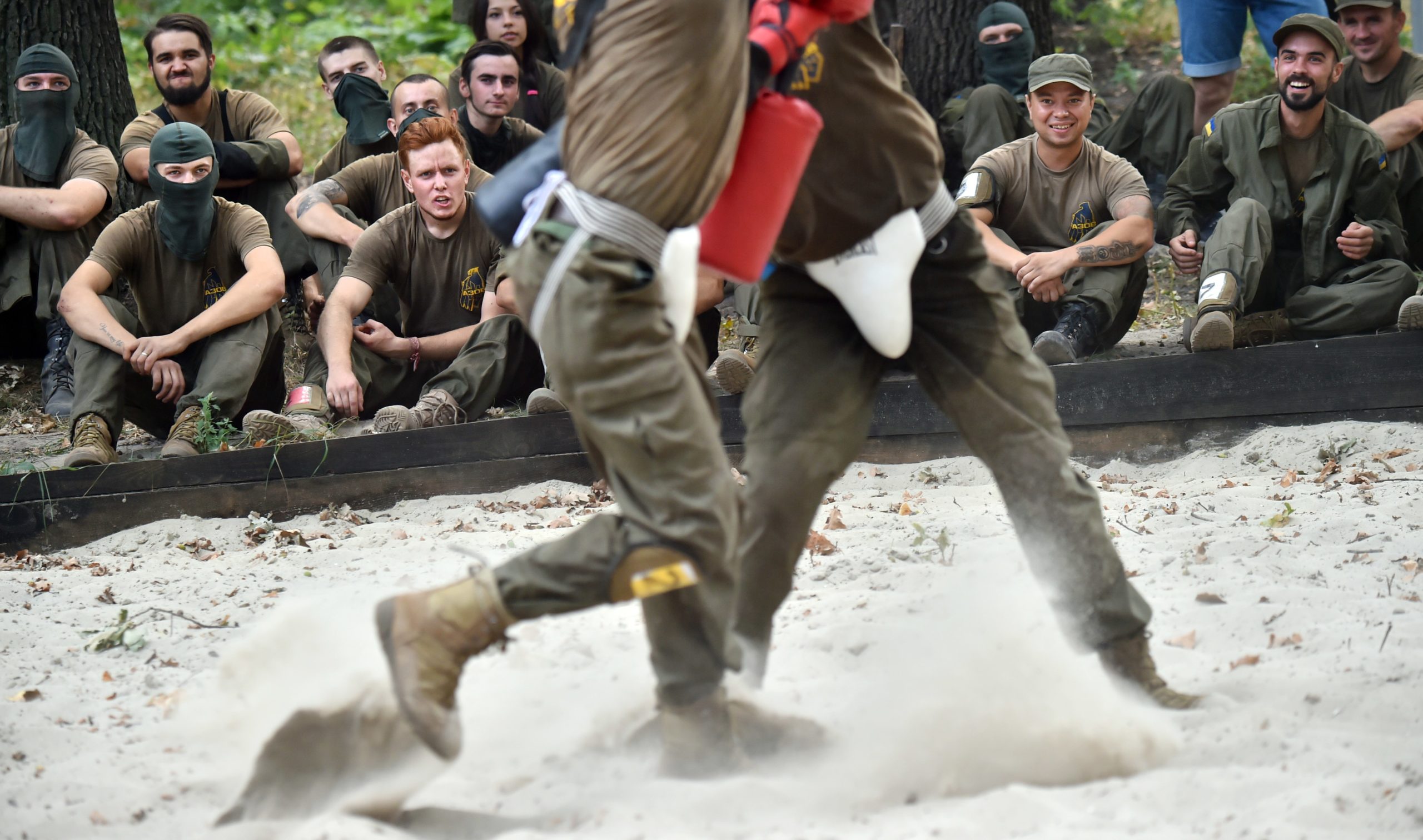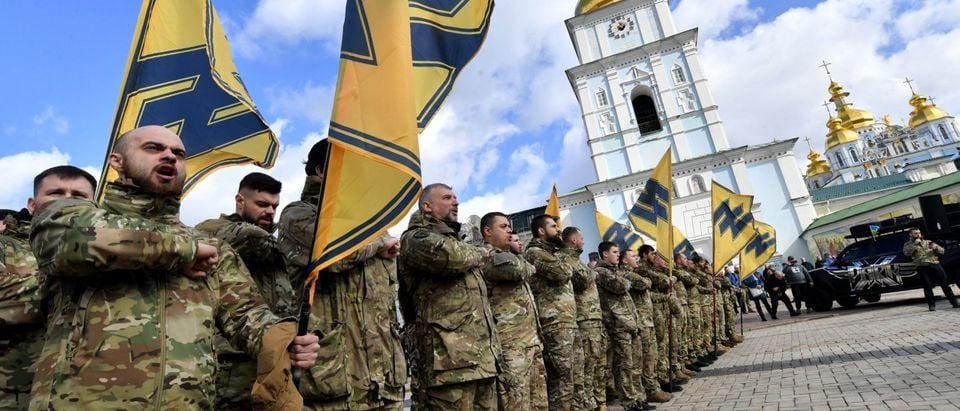What appeared to be a man in a green shirt marked “AZOV” laid on the ground on a stretcher, some of his fingers blackened, covered in blood and dislocated from his right hand.
The video, posted on the Azov Regiment’s Telegram channel, claimed the man was an Azov soldier that had been injured evacuating civilians from Russian attack.
The regiment has been quietly under fire for years from the U.S. government for having alleged neo-Nazi ties. The House voted in 2018 to ban funding of “arms, training, or other assistance” to the Azov Regiment. Forty House Democrats requested in 2019 for the Azov Regiment to be designated as a foreign terrorist organization by the State Department, but were not successful in doing so. Russian President Vladimir Putin, in his justification for waging war in Ukraine on Feb. 24, seemingly pointed to the group when he said one of Russia’s goals was to “denazify” Ukraine.
Asking questions about the regiment’s insignia, rhetoric and activities, and how they tie into “neo-Nazi” allegations, is seemingly taboo and unspeakable at all costs.
“What is there to stop if there are no neo-Nazi behaviors,” Ukraine’s ambassador to the U.S., Oksana Markarova, told the Daily Caller on Thursday in an interview, calling the allegations “Russian propaganda.” Markarova said Ukraine has tried to tell Congress “information about Azov” and has “invited people to come and see how they train.”
“They were defending our country…,” Ukrainian President Volodymyr Zelenskyy said in an interview, adding that when they were established in 2014, they did violate “laws of Ukraine” and some got prison sentences. Now they are part of the Ukrainian military, and are “no longer a self-established group,” Zelenskyy said in an interview with Bret Baier.
The Daily Caller contacted experts at the Wilson Center, the Foundation for Defense of Democracies, American Enterprise Institute, the Foreign Policy Research Institute, the Renew Democracy Initiative, the International Centre for Policy Studies, the Atlantic Council, the Ukrainian Congress Committee of America, the Anti-Defamation League, Brookings, Chatham House, the American Foreign Policy Council, the Center for Strategic and International Studies, the White House, the Pentagon and finally the State Department.
No one was willing to give an on-the-record response about the regiment.
Reports indicate that the regiment’s insignia, members and recruitment strategies appear to blatantly promote neo-Nazi ideology. However, Putin’s stress on Ukraine’s ties with neo-Nazism vastly overstates the degree to which it is prevalent in Ukraine’s society and armed forces, and doesn’t account for the similar movements taking place in Russia.

Servicemen of Ukraine’s Azov Battalion pray in the Ukraine’s second-biggest city of Kharkiv on March 11, 2022, following Russia’s invasion of Ukraine. (Photo by Sergey BOBOK / AFP) (Photo by SERGEY BOBOK/AFP via Getty Images)
The Azov Regiment originated in 2014 as a volunteer militia when Russian and Russian-backed forces originally waged war on Ukraine and occupied Donbas and Crimea. The regiment helped liberate the strategic port city Mariupol, from Russian-backed forces in 2014, and were later incorporated into Ukraine’s National Guard and receive salary from the Ukrainian government.
The regiment is currently fighting on the frontlines of the Russia-Ukraine war. The above-mentioned man suffering on the ground in the Telegram video, according to Azov’s account, was injured along with five others one the way to evacuate civilians in Mariupol, a city that has been under fire from Russian soldiers for months and is facing starvation.
While the Azov Regiment’s insignia, members and recruitment strategies appear to blatantly promote neo-Nazi ideology, the group denies that they have any official affiliations or goals related to white supremacy.
The Azov Regiment’s logo appears to be similar to that of the Nazi Wolfsangel, which has a Z with a bar through it. The group alleges the symbol is an N and an I, standing for “national idea,” and not related to Nazi Germany.
Markarova said that the symbol does stand for “national idea” and that one can allege resemblances for any symbol. She also mentioned the “Z” symbol that Russia has been using in its war on Ukraine. She added Ukraine has tried to tell Congress “information about Azov” and has “invited people to come and see how they train.”
The “Z” symbol “can resemble a lot of things, like part of the swastika or whatever,” she said.
The Social-National Party of Ukraine (SNPU), founded in 1991, used the same symbol as the Azov Regiment in its official logo and also claimed that it stood for “national idea.”
The SNPU, eventually becoming the Svoboda party, had a paramilitary youth wing called Patriot of Ukraine that was led by Andriy Biletskiy. In 2011, members of the Patriot of Ukraine accused Biletskiy of encouraging the group to murder a man that had allegedly attacked their office. Biletskiy was arrested for murder and was released in 2014 after the Maidan revolution under amnesty.
Biletskiy would later become the founder and commander of the Azov Regiment, and some of the members of Patriot of Ukraine would join its ranks.
The regiment’s insignia also included what appeared to be the Black Sun, but the group claimed that it is an ancient Slavic sun symbol, and later deleted it from their official crest. Symbols closely resembling Swastikas have also reportedly appeared on the soldiers’ helmets.
Several members of the Azov Regiment reportedly identify as Nazis and have recently expressed anti-Muslim sentiment, covering their bullets in pig fat in the fight against Russian-backed Chechen mercenaries. The regiment stresses they have Jewish, Russian and Muslim members, and that different political ideologies are accepted, as long as they support Ukrainian nationalism. The group also often communicates in Russian.
Azov fighters of the National Guard greased the bullets with lard against the Kadyrov orcs👊
Бійці Азова Нацгвардії змастили кулі салом проти кадировських орків👊
Підписуйтесь на наш телеграм канал https://t.co/SBQltMr4bM pic.twitter.com/A1ci7tZL8r
— НГУ (@ng_ukraine) February 27, 2022
A spokesman for the Azov Regiment, Andriy Diachenko, reportedly told USA Today in 2015 that 10-20% of the group, which is currently estimated to have 900-2,500 members, identified as Nazis, but that didn’t translate to the official ideology of the group.
The regiment’s co-founder and former commander Biletskiy reportedly claimed in 2010 that Ukraine should “lead the white races of the world in a final crusade … against Semite-led Untermenschen [subhumans].” He has denied any anti-Semitic views in recent interviews.
Biletskiy denied that the regiment affiliates itself with Nazis in an interview published April 6 by the Washington Post.
“We don’t identify ourselves with the Nazi ideology,” Biletskiy reportedly said. “We have people of conservative political views, and I see myself as such. But, as any person, I don’t want my views to be defined by others. I’m not a Nazi. We completely reject it.”
One of the primary cited concerns regarding the Azov Regiment is that it has a global recruitment strategy that attracts some with white supremacist views. The regiment holds recruitment events including a fight club in Kyiv and youth camps, and a political party founded by Biletsky and other veterans of the regiment, the National Corps Party, has invited speakers that promote white supremacy. National Corps also has its own building in Kyiv called the “Cossack House” that features a literary club, Plomin, that publishes its own texts, academic drawing classes and a public sports hall, according to its website.
Although many claim that the National Corps has completely removed itself from the regiment, investigative journalist Oleksiy Kuzmenko wrote in 2020 the “National Corps figures routinely visit the regiment” and has not “depoliticized.”

Vacationing children undergo military training at a Ukrainian volunteer battallion base for the Azov far-right Uklrainian volunteers battalion, in Kiev on August 14, 2015 prior to the adults leaving to the battle fields of eastern Ukraine. AFP PHOTO/ SERGEI SUPINSKY (Photo by Sergei SUPINSKY / AFP) (Photo by SERGEI SUPINSKY/AFP via Getty Images)
One reported recruit to the regiment recorded by TIME expressed his interest in the “rise” of Aryans.
“We’re Aryans, and we will rise again,” one of the alleged recruits, Robin Carell from Sweden, told TIME at an Azov recruitment event in 2019. He added that the “revival of the Indo-European soul” is happening in Ukraine.
A few weeks after interviewing with the outlet, Carell allegedly told TIME that Azov was treating him “like a brother” and that they were sending him to the front lines.
However, the National Corps Party failed to get past the 5% threshold to gain seats in the 2019 Ukrainian Parliamentary election, suggesting the movement is failing to take wide-spread prominence with the Ukrainian people.

Recruits of the Azov far-right Ukrainian volunteer battalion watch their fellow recruits holding a hand-to-hand fight during a recruit competition in Kiev, on August 14, 2015. Two people were killed in another round of intense shelling between Western-backed Ukrainian government’s forces and pro-Russian fighters in the separatist east, officials from both sides said. Ukraine’s military spokesman Andriy Lysenko said one soldier was killed and six wounded in the past 24 hours of fighting across the mostly Russian-speaking war zone. AFP PHOTO/ SERGEI SUPINSKY (Photo credit should read SERGEI SUPINSKY/AFP via Getty Images)
Olena Semenyaka, the international secretary for the National Corps, reportedly invited American Greg Johnson, author of “The White Nationalist Manifesto” to speak at an event in Kyiv in 2018.
“I didn’t come here to speak but to listen. What’s happening in Ukraine is a model and an inspiration for nationalists of all white nations, and I wanted to learn as much as possible about what you’re doing here and see as much as possible. I am enormously impressed and I’ve been taking notes,” Johnson said in his speech.
Another American, leader of the Rise Above Movement (RAM) 28-year-old Robert Rundo, was arrested and charged for a series of violent attacks during protests in Huntington Beach, Berkeley and San Bernardino, California. RAM members were pictured with Semenyaka in Ukraine, according to an FBI statement.
One report from a German newspaper alleges that the regiment handed out recruitment flyers at a rock festival, inviting Germans to “join the ranks of the best” in order to “save Europe from extinction.”
Members of the National Corps reportedly destroyed a Romany camp in Kyiv in 2018, slashing their tents with axes and hammers.
There are also two global terrorists that are often cited as being inspired by the regiment, however, there is no evidence that they trained with them.
In September of 2019, 24-year-old U.S. soldier Jarrett William Smith stationed at Fort Riley was arrested for sharing information on Facebook on bomb-making and discussing killing members of Antifa and bombing a local news station in an online chatroom, the FBI stated. In one of Smith’s online conversations, he said he wanted to travel to Ukraine and join the Azov Regiment, according to the FBI.
The Azov Regiment is pointed to as one of the organizations that radicalized New Zealand mass shooter Brenton Harrison Tarrant, who killed 51 people and injured 40 during two mosque shootings. However, he never mentioned the Azov Regiment in his writings, referencing “Ukraine” once in his white supremacist manifesto published before his shootings. There is no evidence that he ever trained with the Azov Regiment or that he ever actually went to Ukraine, beyond this mention.
“There is no pleasant meadow in which you can lay down your weary body, rest your head and wait for it all to blow over,” Tarrant wrote. “You will find no reprieve, not in Iceland, not in Poland, not in New Zealand, not in Argentina, not in Ukraine, not anywhere in the world. I know, because I have been there.”
The other piece of evidence possibly tying Tarrant to the group is he was also reportedly seen wearing a Black Sun symbol that was previously used on the Azov’s crest. However, the Black Sun is a widespread neo-Nazi symbol not exclusively used by the regiment.
The Russian “Nazi” allegations against Ukraine are not new, being used to blanket Ukrainian leadership since some Ukrainian partisans collaborated with the Nazis in World War II in an effort to gain independence from the Soviet Union. Putin in particular has emphasized the importance of Russia’s victory against the Nazis. The vast majority of Ukrainians, however, fought with the Red Army against Nazi Germany.
Despite its stated goal of denazification, Russia’s war on Ukraine has killed several Holocaust survivors, who lived through concentration camps only to be killed by Russian bombs. The Holocaust memorial to Babyn Yar, where tens of thousands of Jews were buried after being murdered by the Nazis, was also allegedly damaged by a Russian bomb. (RELATED: 96-Year-Old Man That Survived 4 Holocaust Concentration Camps Killed By Russian Bomb: REPORT)
Neo-Nazi movements, rhetoric and symbols have also emerged in Russia, including groups like the Russian Imperial Movement (RIM).
RIM was designated as a terrorist organization by the Trump administration in 2020, the first white supremacist organization to be labeled as such by the U.S. The group offered paramilitary training to neo-Nazi recruits, including “two Swedish individuals” who “committed a series of bombings in Gothenburg, Sweden, targeting a refugee shelter, a shelter for asylum seekers, and a café” after their course with RIM, according to the State Department.
Russia’s neo-Nazi movement also reportedly extends to skinheads and paramilitary groups that have allegedly fought with Russian forces in Eastern Ukraine.
Russian Foreign Minister Sergei Lavrov said an apparent anti-Semitic statement May 1 that the Israeli minister of foreign affairs called “unforgivable and outrageous.”
“So what if Zelenskyy is Jewish? The fact does negate the Nazi elements in Ukraine,” Lavrov said, claiming “Hitler also had Jewish blood” and that “the most ardent anti-Semites are usually Jews.”
The Ukrainian Parliament passed a law criminalizing anti-Semitism in February with a prison sentence of up to five years.












